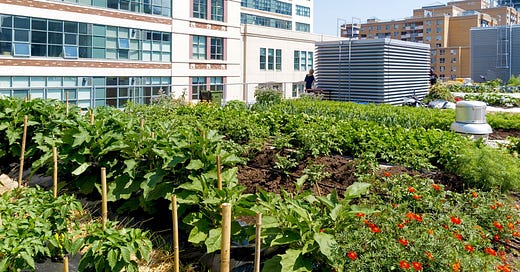Urban agriculture and heavy metal contaminants
Turns out that all that kohlrabi and kale from the backyard garden is safe to eat
When I was a child growing up in Appalachia, my family had a backyard garden, a small patch where my father planted lettuce, cabbage, tomatoes, peppers, and anything else we thought we could grow and enjoy eating. It was something that seemed to have no downside, from the wintry days of perusing the Burpee seed catalogue, to the mild industry of spading the soil in the spring, to the fresh greens and vegetables in summer and fall.
Yet that lettuce and those onions grew just a block an a half from a Union Carbide factory that produced graphite. At all times of the day huge amounts of smoke billowed forth from the factory’s smokestacks, with soot and ashes settling all over the little town we lived in. That soot and ash also fell on our vegetables and on the soil they grew grew in.
As the factory burned coal to fire the plant, I imagine that the soot and ash contained heavy metals like mercury and chromium. And it is not a bad guess to think that the tomatoes and fresh peppers that we cherished also contained some of those toxic metals.
What my family was practicing back then is now called urban agriculture. A lot of folks encourage urban agriculture. The federal Agricultural Department has a program to support it. And lots of folks are quick to tout the benefits of growing food in abandoned lots and on the roofs of skyscrapers. Urban gardens are believed to make for better, more attractive communities and enhance education and recreation.
But is the food from these abandoned lots and backyards wholesome to eat? Not many folks live close to a graphite factory, but there are many sources of pollution in cities, and many of these pollution sources contain heavy metals. Heavy metals are, well, heavy. They are metals with high densities and high atomic weights. Living organisms require some heavy metals in their systems for proper health. Most folks know that they need iron in their diets for blood functioning. Other essential heavy metals, are copper manganese, cobalt, zinc, and nickel. Although they are essential, these elements are only used in trace amounts. All the copper in your body would weigh about as much as three or four poppy seeds on your bagel.
The other heavy metals are lead, cadmium, mercury, chromium, and aluminum. Some people include arsenic as a heavy metal, too. These are toxic to highly toxic substances. A healthful diet, including whole grains, lots of fruits and vegetables, with small amounts of meat and fish should be sufficient for most individuals to sustain their levels of essential heavy metals and other nutrients. We cook vegan dishes at home. (My wife is vegan; I am not.) We get iron in our diets by cooking with iron cookware, yes a plain old iron skillet and pot. It seems to work just fine.
Looking at rooftop gardening in New York City, scientists found relatively low concentrations of heavy metals in the rooftop garden beds, which leads them to think that the air pollution that deposits such metals may be less so at the rooftop than they might be at street level. Similar results were recently found by scientists examining the use of wastewater and biochar, a type of charcoal that is used as a soil amendment, in the urban farms of Ghana. The researchers found low levels of heavy metals in the garden soils. They did nonetheless find traces of e coli in the soils and even found fecal coliform on the garden plants.
Further, the fruits and vegetables from urban farms and gardens are safe to eat. Scientists looked at concentrations of cadmium and lead in produce from urban agriculture in San Francisco and found—across the board, from kale to kohlrabi—the concentrations for the two heavy metals were far below the maximum limits set by the Food and Agriculture Organization and the World Health Organization. The scientists looked for no other contaminants in the food, but at least as far as cadmium and lead, the food was safe.
Though the science seems to indicate that urban farming and gardening is safe and healthful, precautions should be taken. The USDA recommends soil testing for urban agriculture and even subsidizes the tests. Cleaning vegetables is also a smart thing to do, no matter where they come from.
For more environmental news follow me on Twitter @EcoScripsit.







Interesting that the abstract for the New York rooftop garden paper suggests NOT composting used mulch or unmarketable portions of vegetables to return to the soil, as this could increase heavy metal build up. It would be interesting to know if other studies have concluded the same as, if so, this would be an important tip to get out urban gardens (many of which are probably composting onsite extensively).